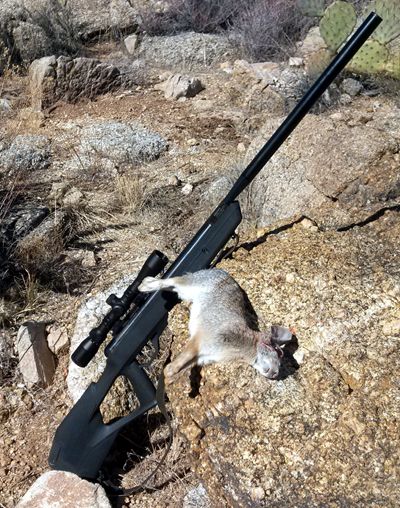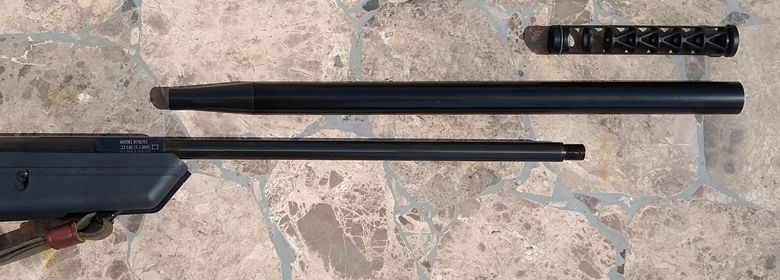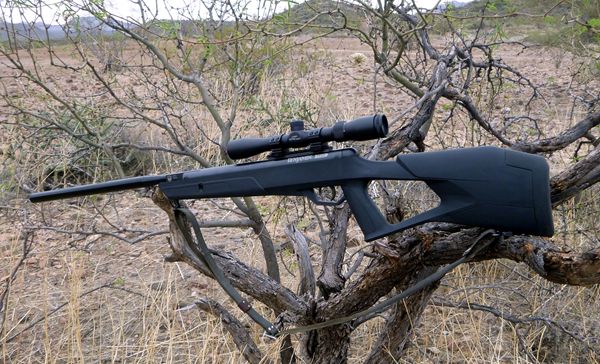
| Articles | Documents | Equipment | Events | Links | Membership | Miscellaneous | Scrapbook | Targets | What's New |
|
Air Force Benjamin Trail NP2 | March 2019 | ||
| Dan Martinez | |||
A while back, I went on a relaxing boondock camping trip with my sons (just
camping), and they happened to bring along a break-barrel air rifle that came
into the family. The last air rifle I bought was one of the large, cheap,
heavy spring-piston ones from China back in the 90’s. It made a lot of fury
when fired, but I couldn’t hit much of anything with it.
This rifle that the boys had, came from Grandpa. He bought it several years
ago to chase cats with! Rated for 1000 fps, when he told me about this, I knew
that it was much too powerful to shoot cats with, unless you intended to kill
them. As a matter of fact, I too have a cat stinger, but it’s a cheap plastic,
low power handgun that shoots .177 cal. BBs. It’s so slow that you can watch
the BBs arc their way over to the target.
So Grandpa ended up giving the .177 caliber Winchester air rifle to the boys.
But this got me thinking about air rifles again. I didn’t want to drop a lot
of dollars, but I wanted something useful. I wanted better accuracy than that
old stinky Chinese thing. I wanted something powerful enough that could
conceivably be used to hunt small game with. When I stumbled upon some YouTube
videos of people hunting turkey (!) with the Benjamin Trail NP2, that sold me
on buying one of these in .22 cal.
NP2 stands for Nitro Piston version 2. Instead of a steel spring that is
compressed when the rifle is cocked, the rifle uses an air spring, specifically,
nitrogen gas. This rifle is available with either a hardwood or with a black
synthetic stock. As you can see, mine is the plastic stocked version.
The barrel appears to be a bull barrel of around 20” in length, but in reality,
the barrel is only 16” long and only .590” in outside diameter. Appearances are
deceiving because the rifle is suppressed. The suppressor system consists of a
5.6” long plastic suppressor baffle, a 14.5” long tubular aluminum barrel shroud
of 1.0” diameter, and a plastic reducing cone near the breech end of the barrel.
Sorry, but I have not tested either how effective the suppressor is, nor if
accuracy is affected by shooting the rifle without the suppressor system in place.
The rifle comes with a CenterPoint 3-9x32mm scope. Both Benjamin and CenterPoint
are brands of Crosman. Crosman bought out the Benjamin Sheridan company in 1992.
The rifle is assembled in Bloomfield, New York.
You may have noticed the interesting stock configuration. No, the thumbhole-pistol
grip configuration is not my favorite, but I can say that I don’t mind it. It
probably makes the long heavy trigger easier to manage. The trigger does have a
decently good break, but it is heavy and long.
One thing that I do appreciate, is that the safety is not automatic. That’s one
thing I hated about that old Chinese air rifle – every time you cock it, the safety
is engaged automatically. The safety on the Benjamin Trail is entirely under the
shooter’s control at all times. The safety is located within the trigger guard,
right in front of the trigger. Pull back to engage, push forward to disengage.
I had never done any group work with this rifle, but I figured that I needed to do
a little, at least, for this article. I scratched out a 19 yard range in the
backyard. Firing was from inside the house, through the open sliding glass door,
sniper style. Technically, shooting air rifles in my neighborhood is not allowed
by HOA rules. Though suppressed, there is still a bit of a crack when this rifle
goes off. I hoped that firing from inside the house would be enough to keep the
sound a little more stealthy.
My target was taped to a piece of ¾” plywood. The sound of the pellets impacting
the plywood is still a bit of a giveaway though. The gun definitely hits pretty
hard. The gun is rated to fire standard .22 lead pellets up to 950 fps, using
alloy pellets, up to 1100 fps.
I had three types of pellets on hand, and I only shot one 5-shot group with each
type. You can see the results in the photo below. The best group was with the
Ruger Superpoint pellets in this abbreviated test. By the way, depth of
penetration seemed to be deepest with the Ruger pellets as well. I measured
.22” from the face of the plywood to the back of the pellet. This might mean a
full half-inch of penetration into the dense plywood, but I could not measure
that without digging pellets out of the wood, which would likely affect the
measurement.
I’m no expert at group shooting with spring-piston air rifles. Because of the
reverse recoil that this type of air rifle generates, there is supposed to be
a fine art to achieving best groups. Air gunners talk about using the
“artillery hold” when shooting groups with spring piston air rifles. That
basically means allowing the gun to free-recoil as much as possible. I tried
to do that as best as I could, but I’m sure that my technique is not the best.
Just for the fun and challenge, Ben and I have gone out on a couple of quail
hunting expeditions with the Benjamin .22 and the Winchester .177. No quail
have yet been taken. We all know that Gambel’s quail are notorious runners
and are really tough to get close to, and they don’t like to sit still. Maybe
if we tried chasing Mearns quail. They will sit tight for you to get close
enough. The only problem with Mearns quail is seeing them before you step on
them. Their camo is that effective, and they will sit that tight.
On one of our expeditions, we did have a cottontail sit still long enough to
take a hit with the .22. All I can say is that there was certainly ample
power to take the bunny cleanly with a head shot.
The Benjamin was also successful at taking down a big fat Eurasian collared
dove in the backyard, again using the house sniper through the open door
technique.
I have no plans to try turkey hunting with this rifle. Still, it’s pretty
fun to have a rifle with this level of power that doesn’t burn powder. It
is available today at Cabela’s (and other places as well) for right around
$200.
© Honeywell Sportsman Club. All rights reserved. | |||
|
The Honeywell Sportsman Club is a small group of shooting and outdoor enthusiasts in the Phoenix, Arizona area. Our website is ad-free and completely free to use for everyone. But we do have expenses that we need to cover, such as the web hosting fee and our liability insurance. If you enjoyed visiting our website, found it useful in some way, or if you enjoyed reading this story, please consider tipping us through our PayPal donation jar below. Thanks for visiting, and come back soon. |

|
|





